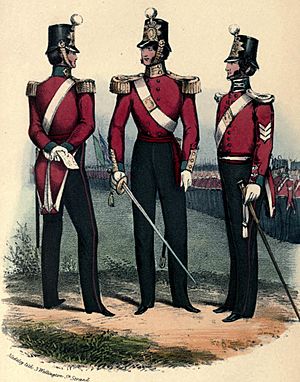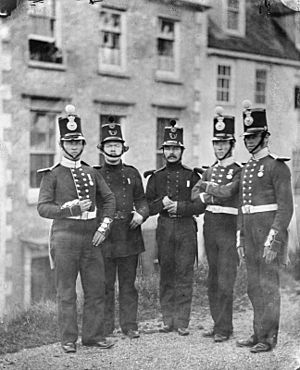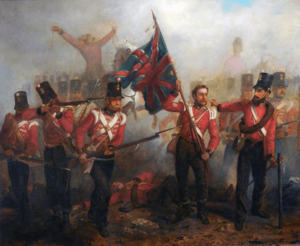Albert shako facts for kids
The Albert shako was a type of hat worn by soldiers in the British Army. It was used between 1844 and 1855. This special hat was an improved version of an earlier idea called the Albert hat. Prince Albert first suggested the Albert hat in 1843. He wanted to replace the old "bell-top shako" that soldiers wore.
The Albert hat was about 18 cm (7.1 inches) tall. This was a bit taller than the old bell-top shako. It had a brim all around, like a normal hat, to protect soldiers from the sun. It even had new ways to let air in, which was very modern for the time.
However, when the Albert hat was shown to the public in September 1843, people made fun of it. The Duke of Wellington, who was in charge of the British Army, changed the design. His version, called the Albert shako, only had a brim at the front and back. This new shako started being used in 1844. It replaced the bell-top shako for many infantry (foot soldiers) and dragoons (horse soldiers). Even fusilier regiments and grenadier companies, who used to wear big bearskin hats, started wearing the Albert shako.
Soldiers often found the Albert shako heavy and uncomfortable. Because of this, they sometimes wore a simpler forage cap when they were fighting. The Albert shako was replaced in 1855 by a new shako design from France.
Prince Albert's Hat Idea
Prince Albert helped design the Albert hat in 1843. He wanted to make the British Army's uniforms more practical. He thought the army's uniforms were not as good as those worn by the Royal Navy. This was one of Albert's first times getting involved with the British Army. He had been made a field marshal in 1840 when he married Queen Victoria.
Before Albert's hat, the army had worn the "bell-top shako" since 1829. This old shako was about 16.3 cm (6.4 inches) tall. It only had a brim at the front. Albert's hat was taller, about 18 cm (7.1 inches). Its brim went all the way around, about 6.7 cm (2.6 inches) wide. This full brim was what made it a "hat" instead of a "shako."
The bell-top shako was wider at the top. But the Albert hat got narrower towards the top, measuring about 15.9 cm (6.25 inches) across. A ball on the front top of the hat was like the feathers (plumes) on older shakos. Prince Albert thought old shakos made soldiers' heads too hot. So, he added vents to his hat, which was a new idea back then. Two brass tiger heads on the sides hid air holes. There was also a flap that could be opened in hot places.
The hat was covered in black cloth. It had a white band around the bottom. The brim was made of black leather. A special plate was on the front of the hat. It had a royal crown above a Maltese cross with the regiment's number.
Not many of these original Albert hats were made. Some might have been tested by the 49th (Princess Charlotte of Wales's) (Hertfordshire) Regiment of Foot. A real Albert hat is kept at the National Army Museum.
When Albert showed his hat on September 21, 1843, people laughed at it. A cartoon in Punch magazine made fun of it. In October, the Illustrated London News said that people clearly did not like it. They thought it would not replace the hats soldiers wore then.
The Albert Shako Design

In October 1843, the Duke of Wellington, who was the head of the British Army, changed Albert's hat. He made it shorter by about 7.6 cm (3 inches). He also changed the brim so it was only at the front and back. The cross-shaped plate on the front was replaced with a star-shaped one for most soldiers. Because the brim was changed, this new design was called the Albert shako.
People generally did not like the new shako either. They thought it looked like hats worn by German soldiers from the 1500s. By December, a new, slightly changed design was suggested. This one was taller, about 17.1 cm (6.75 inches). The brass tigers were removed, and a chin strap was added. This final design was similar to the shako worn by the Austrian army at the time.
Officers' shakos were made of black beaver fur on a felt base. The top, bottom edge, and brims were made of shiny black leather. The front brim stuck out about 6 cm (2.38 inches), and the back brim about 3.2 cm (1.25 inches). The hat got a little narrower towards the top. The chin strap was leather, with a fancy gold chain over it. This chain was attached to the sides with gold decorations. The shakos for other soldiers were similar. But they were made of napped felt, which was heavier. Their metal decorations were brass instead of gold.
A waterproof cover was given with the shako. This was for use in bad weather.
Shako Plate

The rules said that officers' shako plates should be gold-colored. But some regiments had silver details. For officers of regular foot soldiers, the plate was usually an eight-pointed star with a crown on top. Inside the star was a wreath of leaves and a band. This band usually had the regiment's name or motto. The center showed the regiment's number. Battle honors (important battles they fought in) were listed on the points of the star. The shako plate for other soldiers was simpler and made of bronze. It was round, with a crown on top and the regiment's number inside a wreath.
Light companies (and light infantry regiments) had a bugle in the center of their plate. Grenadier companies had a grenade. Fusilier regiments wore a grenade-shaped plate. Rifle regiments wore a bronze plate shaped like a bugle.
Plume
The ball-shaped plume (also called a tuft) was kept from older shakos and the Albert hat. The ball was made of worsted wool and was about 6.4 cm (2.5 inches) wide. It was attached to the shako with a metal holder.
The color of the plume showed different roles:
- Regular foot soldiers wore red with a white tuft.
- Light infantry regiments and light companies wore green with a white tuft.
- Fusilier regiments, grenadier companies, and the Royal Marines wore plain white.
- Rifle regiments wore green with a black tuft.
- Regimental staff officers wore a plain red plume.
- field officers wore a red horsehair plume instead of the ball.
In Service
The Albert shako began being used in 1844. It replaced the old bell-top shako for infantry and the bearskins for fusiliers and grenadier companies. The Foot Guards kept their bearskins. Highland regiments kept their feather bonnets. Light dragoons and the Corps of Royal Sappers and Miners also got the Albert shako.
Soldiers complained that the Albert shako was heavy and uncomfortable. It would often fall off during battles. One story says that after the Battle of Chillianwala in 1849, the battlefield was covered with discarded shakos.
The shako was used in the Crimean War (1853–1856). This was one of its last times being used in real fighting, as it was replaced in 1855. Soldiers usually wore the shako in the early battles of the war, like Alma and Inkerman. But later, they often switched to the round forage cap. Colonel George Bell complained in 1854: "The next thing I want to throw away is the terrible Albert, as it is called. A man could fry his beef on it at midday in this hot weather. The top is shiny leather, which attracts even more sun to make his brain mad."
The Albert shako was officially replaced by the 1855 French pattern shako. This new shako was part of changes that year to make British Army uniforms less fancy. The French pattern shako was shorter and sometimes looked like a kepi. We don't know if it was made smaller to be more comfortable or just to copy the French army's hats. The ball-shaped plumes from the Albert shako were kept for the new hats. The Sappers and Miners kept the Albert shako until 1857. The shako was also used by the yeomanry (a type of volunteer cavalry) for a long time after the regular army stopped using it.
|
See Also




